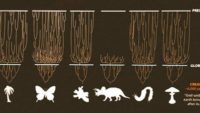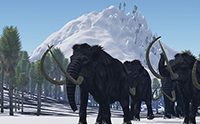By John Wahl The family of giant silk moths, or Saturniidae, includes the largest—and arguably most beautiful—moths in the world. …read more Read more here: AIG Daily
Engineers want to copy the design principles they’re discovering in nature’s flexible defences. …read more Read more here: creation.com
By Ken Ham At the Ark Encounter, we try to combat the notion that our ancestors were somehow unintelligent. For example, we have an exhibit that highlights the genius of ancient man. We mention how people shortly after the Flood built incredible feats of engineering, such as the pyramids in Egypt—and we still don’t know for sure how they did it, although some plausible explanations have been suggested. But obviously they were intelligent! Well, a new find from a cave in southwestern Germany again confirms that our ancestors were intelligent. Researchers found a “carefully …read more Read more here: Ken [More]
By Multimedia On this episode of ID the Future, Casey Luskin talks with bioethicist Wesley J. Smith about a recent article he wrote at First Things. In this article, Smith responds to an accusation that he is “anti-science” for suggesting that science should have ethical boundaries. Listen in as Luskin and Smith discuss how the “anti-science” label, along with similar terms, is often used to try and suppress dialogue and protect scientific orthodoxy. Your browser does not support playing Audio, please upgrade your browser or find our podcast on podOmatic Download Episode …read more Read more here: id the future [More]
By Ken Ham The short answer is no—it’s definitely not. You see, no one knows where the Garden of Eden was. Many people think it is in the Middle East because that’s where the Tigris and Euphrates are today, and Genesis 2:14 mentions both these rivers in relation to the garden. But Genesis 2:10 says, “Now a river went out of Eden to water the garden, and from there it parted and became four riverheads.” Nothing like one river becoming four exists in the Middle East today. So this area can’t be the location of the Garden of Eden as [More]
By Dr. Nathaniel T. Jeanson All of these data together lead to testable scientific predictions that put the evolutionary and old-earth creation models to shame. …read more Read more here: AIG Daily
By Dr. David Menton “The hearing ear and the seeing eye, the Lord has made them both” (Proverbs 20:12). …read more Read more here: AIG Daily
By Creation Moments On our previous program, we told you how evolutionists enjoy finding fault with what they consider to be bad designs in nature – particularly the poorly designed human body. They aren’t using such arguments to critique evolution, of course. They are poking an accusing finger into the eye of God. If God is so smart, they taunt, why did He make so many mistakes? read more …read more Read more here: Creation Moments
By Bodie Hodge Noah’s Ark has been a popular subject for artists throughout the centuries. However, it is not easy to adequately depict this vessel. …read more Read more here: AIG Daily
In trying to determine the boundary between Flood and post-Flood deposits, help may come from an unexpected and slithery source. …read more Read more here: creation.com
Why think God exists? Here are several reasons why. …read more Read more here: creation.com
By Creation Moments We’ve all seen advertisements from retail establishments selling merchandise they call “slightly imperfect”. Well, if you listen to evolutionists, we humans are more than slightly imperfect. As one writer claims, “From our knees to our eyeballs, our bodies are full of hack solutions.” read more …read more Read more here: Creation Moments
By Ken Ham The article was written by evolutionary biologist Josh Rosenau, programs and policy director of the US National Center for Science Education. In this article, it is clear that he was not interested in conducting careful research, as one would normally expect from a scientist. Instead, I don’t believe he had any intention of accurately portraying the content of the Ark Encounter exhibits. For instance: He accuses the Ark Encounter exhibits of supposedly promoting the “obliteration of all humans” as “praiseworthy.” I challenge this evolutionist to actually document this claim—which he can’t since it’s a false claim. No! [More]
The Hebrew word khûg, used in Isaiah 40:22, refers to a spherical earth. …read more Read more here: creation.com
Most people are familiar with the concept of an ice age, a time when glaciers covered much of the earth’s land surface. Secular scientists believe there were at least five major ice ages in earth history that happened over millions of years. But a straightforward reading of the Bible indicates a young age for the earth—about 6,000 years. How should Christians respond to claims that ice age evidence proves an old earth? Do the scientific data really support multiple ice ages over long time periods? And how does this fit into biblical history? More… …read more Read more here: icr.org [More]
By Creation Moments Creationists and proponents of Intelligent Design don’t agree on several matters, but we do share the same views on the utter impossibility of evolution to account for the existence of all living things. Recently we came across a wonderful explanation of how plants got here by way of evolution. It’s from the book Billions of Missing Links, and it’s so good, I just had to share it with you today. read more …read more Read more here: Creation Moments
By Ken Ham An article titled “The Selfish Generation” discusses the results of this survey about how different generations look at morality. They found that a mere 37% of Americans under 30 “say that people should ‘always do what is right,’” 42% think people should “balance what is right with what is best for them,” and 15% “always do what’s best for them.” In the same age group, almost a quarter say they “generally do what is best for them” as opposed to what is right. Of course, we really need to ask them how they determine what is “best,” [More]
By Dr. Elizabeth Mitchell Walking fish, waterfall-climbing cavefish with a tetrapod-like pelvic girdle, and the gene that shapes skates’ gills all supposedly show how legs evolved. …read more Read more here: AIG Daily
By Ken Ham Of particular concern is question 19 on the Australian census form, which is the only optional question and is the religious identity question. …read more Read more here: AIG Daily
We respond to a list of skeptical arguments against the Bible and Christianity. …read more Read more here: creation.com
By Creation Moments In their book A Closer Look at the Evidence, public school science teachers Richard and Tina Kleiss write that our conscience is an undeniable evidence of God’s existence. Another evidence is the intricate design of nature. After all, the Bible tells us in the book of Romans that He makes Himself evident to everyone so that no one can claim that He does not exist. read more …read more Read more here: Creation Moments
A spectacular full scale Ark, right next to the highway of one of the world’s busiest airports. …read more Read more here: creation.com
Biophysics researchers recently demonstrated that people can see just one photon of light. This led them to ask how evolution could have crafted a visual system sophisticated enough to overcome the overwhelming problem of discerning single photons from the sea of electromagnetic, molecular, and electrochemical “noise” inside a human head. More… …read more Read more here: icr.org
By Ken Ham Well, let’s look at this new study regarding robots and the supposed first land animals. Evolutionists believe that somewhere around 360 million years ago “early terrestrial animals began moving about on mud and sand.” This new study looked at the African mudskipper fish and modeled a robot after it. The study concluded that the powerful tails that these supposed early terrestrial animals used as fish may have been important in helping them maneuver on the mud and sand since the mudskipper uses its tail, and the use of a tail significantly helped the robot. Studying the way [More]
By Frank Sherwin If everything that God made was good, where did disease-causing mosquitoes come from? What is the origin of mosquito-borne diseases? …read more Read more here: AIG Daily
By Creation Moments Do you remember when home computers used floppy disks? Magnetic floppies were replaced by optical discs, using laser technology, and now we depend on hard drives, flash drives and cloud drives for the storage and retrieval of digital data. But someday even our most advanced data-storage systems will give way to the latest and greatest advances in technology. read more …read more Read more here: Creation Moments
By Ken Ham We’re very excited about partnering with the Wild family to produce these family-friendly DVD episodes. The Wilds are a homeschool family that serve the Lord as missionaries to an unreached people group in the jungles of Southeast Asia. We’ve partnered with them to produce a reality DVD series about their life in the jungle. The DVDs have been extremely popular with children and parents alike. Kids love the Wild brothers’ crazy adventures, and parents are thrilled with the solid biblical content that helps their kids think biblically about important issues. You can watch the Wild brothers’ TV [More]




















![Please Forgive Me [Live] Please Forgive Me [Live]](http://img.youtube.com/vi/aGW1x_lLp2o/0.jpg)
![Leaning On the Everlasting Arms [Live] Leaning On the Everlasting Arms [Live]](http://img.youtube.com/vi/MvNdFIZRJRQ/0.jpg)



















